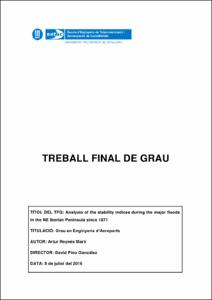Mostra el registre d'ítem simple
Analysis of the stability indices during the major floods in the NE Iberian Peninsula since 1871
| dc.contributor | Pino González, David |
| dc.contributor.author | Reynés Martí, Artur |
| dc.date.accessioned | 2016-07-25T11:13:16Z |
| dc.date.available | 2016-07-25T11:13:16Z |
| dc.date.issued | 2016-07-13 |
| dc.identifier.uri | http://hdl.handle.net/2117/89142 |
| dc.description.abstract | Floods are one of the main natural hazards affecting worldwide population. The Western Mediterranian region is one of the areas in risk of suffering these phenomena. In this region, floods have lead in high damages in the infrastructures and agriculture terrains. Moreover, these metrological phenomena have lead in hundreds of human fatalities. For that reason, is required to take over a wide research of historical, hydraulical, hydrological and meteorological in order to analyze which was the source and to be able to predict these hazards in the future. We have focused our study in the meteorological reconstruction of these historical floods. By using the 'Prediflood' database, we have selected the 23 most catastrophic floods that affected the Northeast of Iberian Peninsula between 1874 and 2000. Then, using NOAA 6 hourly 20th Century V2 Reanalysis Data Composites we have analyzed the Convective Available Potential Energy (CAPE) and its evolution during all these years, the convective timescale (τc). With this calculus and the hypothesis of several authors we have tried to conclude if these floods were convective equilibrium episodes or non-equilibrium ones. As a result, we have observed that τ by itself do not guarantee a correct definition of one of these regimes. Helped with CAPE, this difference could be easily determined. At the same time, it is also relevant that the hypothesis of previous authors about limit value of τc. in order to determine the regimen have been refused because the values were higher than expected. Then, we have studied the spatial evolution of convective timescale between floods with similar characteristics of CAPE and τc in the same season of the year with the intention to observe if τc varies in the same way in Catalonia and its surroundings. The obtained results in this chapter demonstrate low relation between episodes of similar characteristics. This fact have lead us to write several conclusions and eventual recommendations which would have to allow an study with better reliability, obtaining this way conclusive results. |
| dc.language.iso | cat |
| dc.publisher | Universitat Politècnica de Catalunya |
| dc.rights.uri | http://creativecommons.org/licenses/by-nc-sa/3.0/es/ |
| dc.subject | Àrees temàtiques de la UPC::Enginyeria agroalimentària::Ciències de la terra i de la vida::Climatologia i meteorologia |
| dc.subject.lcsh | Floods-Spain |
| dc.subject.other | Historical floods |
| dc.subject.other | 20th century reanalysis |
| dc.subject.other | Stability indices |
| dc.title | Analysis of the stability indices during the major floods in the NE Iberian Peninsula since 1871 |
| dc.type | Bachelor thesis |
| dc.subject.lemac | Inundacions -- Espanya |
| dc.rights.access | Open Access |
| dc.date.updated | 2016-07-14T08:08:43Z |
| dc.audience.educationlevel | Estudis de primer/segon cicle |
| dc.audience.mediator | Escola d'Enginyeria de Telecomunicació i Aeroespacial de Castelldefels |
| dc.audience.degree | GRAU EN ENGINYERIA D'AEROPORTS (Pla 2010) |


